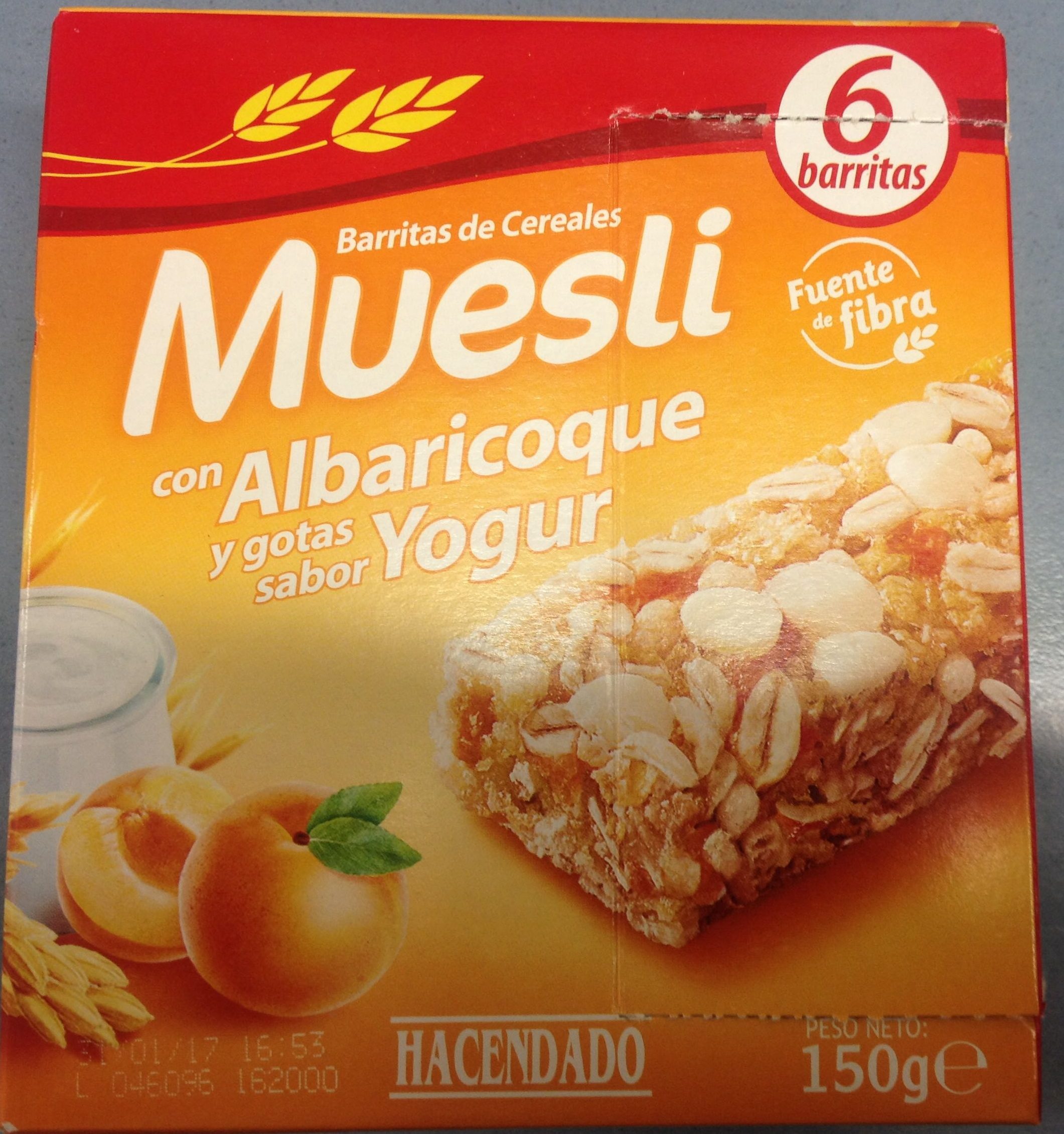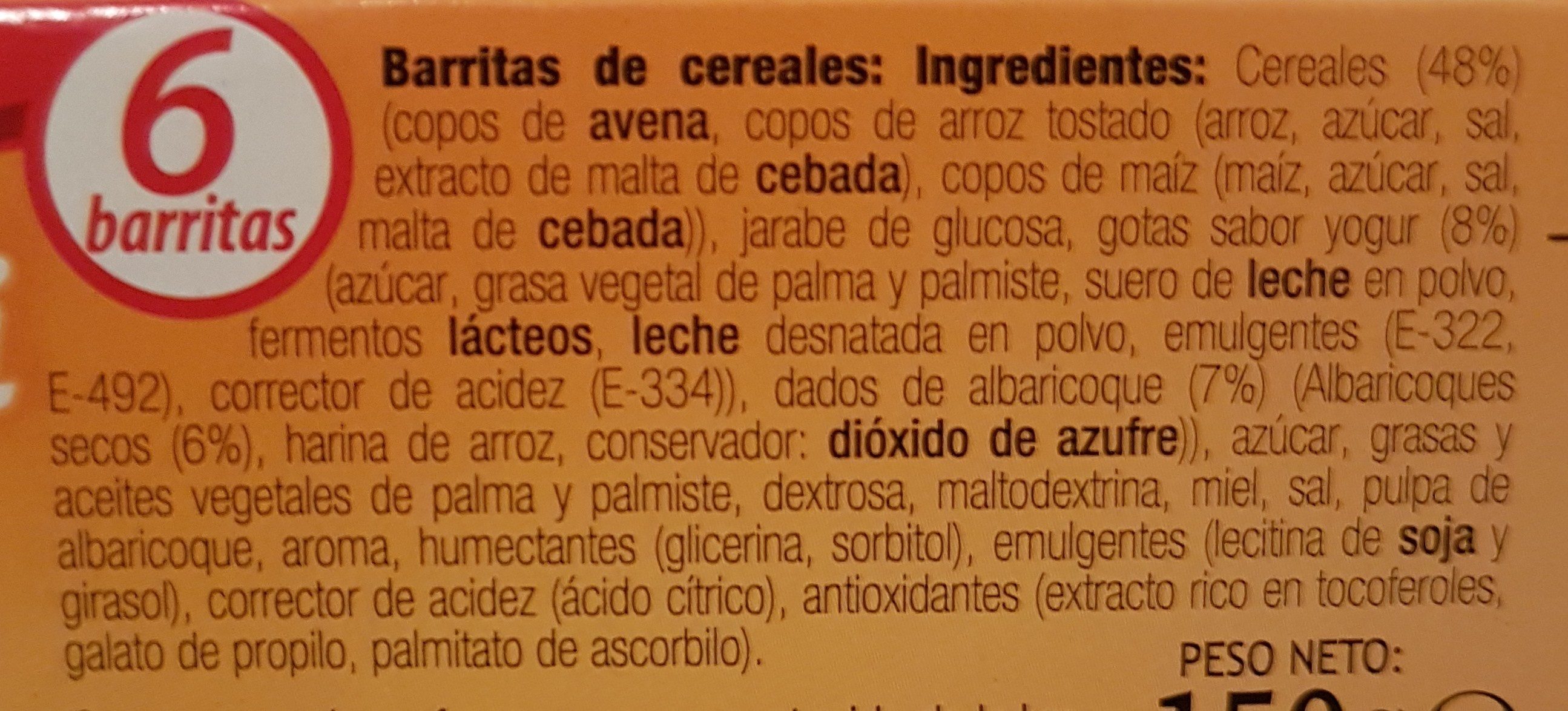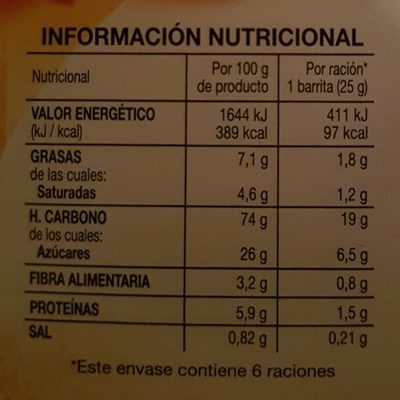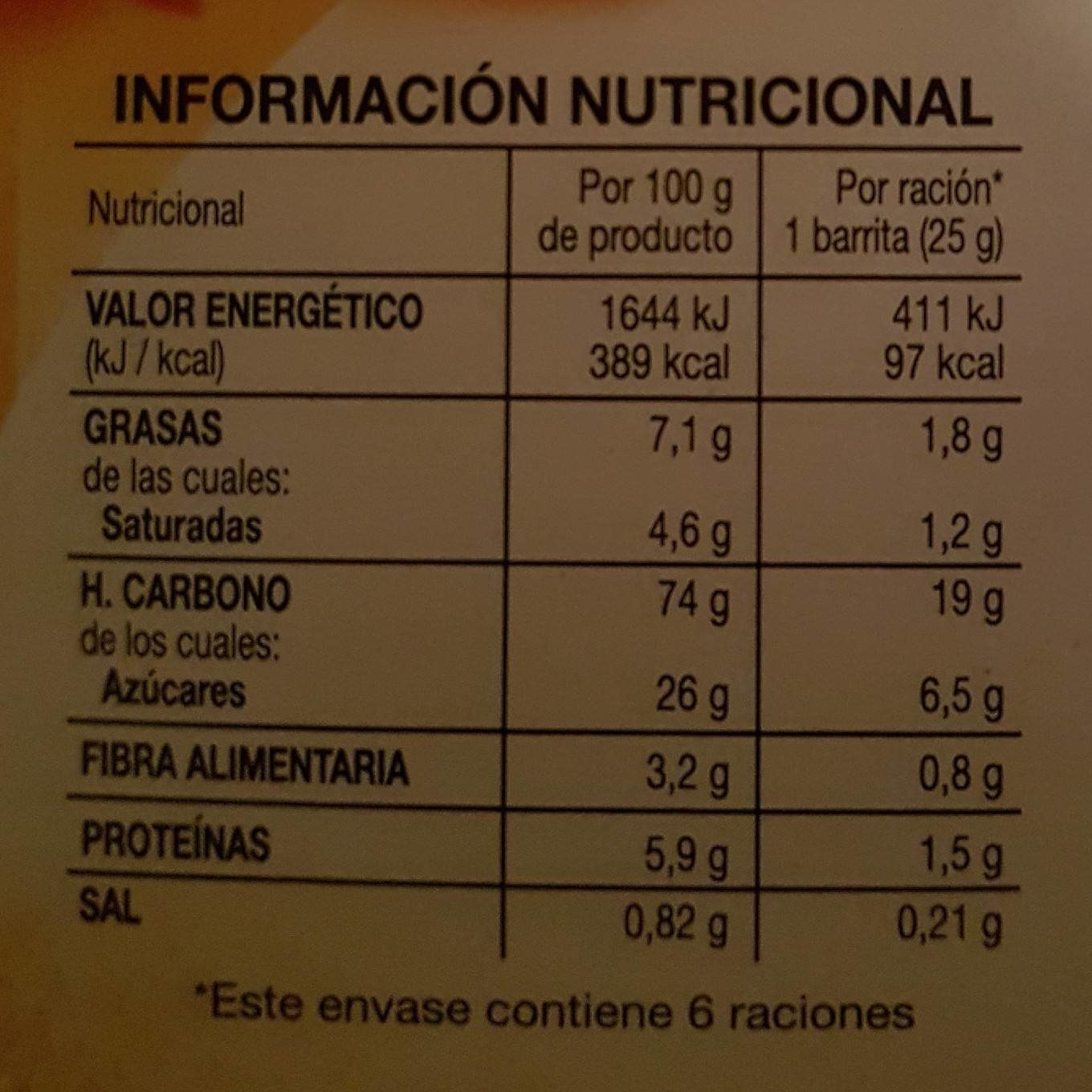Help us make food transparency the norm!
As a non-profit organization, we depend on your donations to continue informing consumers around the world about what they eat.
The food revolution starts with you!
Barre muesli abricot & yaourt - Hacendado - 150 g e (6 * 25 g)
Barre muesli abricot & yaourt - Hacendado - 150 g e (6 * 25 g)
This product page is not complete. You can help to complete it by editing it and adding more data from the photos we have, or by taking more photos using the app for Android or iPhone/iPad. Thank you!
×
Barra-kodea: 8480000093479 (EAN / EAN-13)
Kopurua: 150 g e (6 * 25 g)
Ontziratzea: en:Plastic, en:Box, en:container
Markak: Hacendado
Kategoriak: en:Plant-based foods and beverages, en:Plant-based foods, en:Snacks, en:Breakfasts, en:Cereals and potatoes, en:Sweet snacks, en:Cereals and their products, en:Bars, en:Breakfast cereals, en:Cereal bars, Muesli, en:Fruits cereal bars, en:Apricot cereal bars
Etiketak, ziurtagiriak, sariak:
en:Green Dot
Matching with your preferences
Health
Osagaiak
-
48 ingredients
: Cereales (48%) (copos de avena, copos de arroz tostado (arroz y azücar, sal, extracto de malta de cebada), copos de maiz (maiz, azücar, sal, malta de cebada)), jarabe de glucosa, gotas sabor yogur (8%) (azücar, grasa vegetal de palma y palmiste, suero de leche en polvo, fermentos lâcteos, leche desnatada en polvo y emulgentes (E-322 y E-492), corrector de acidez(e334), dadas de albaricoque (7%) (Albaricoques secos (6%), harina de arroz, conservador: dioxido de azufre)), azücar, grasas y aceltes vegetales de palma y palmiste, dextrosa, maltodextrina y miel, sal, pulpa de albaricoque, aroma, humectantes (glicerina y sorbitol), emulgentes (lecitina de soja y girasol), corrector de acidez (âcido citrico)) antioxidantes (extracto rico en tocoferoles, galato de propilo, palmitato de ascorbilo)Alergenoak: en:Gluten, en:Soybeans, en:Sulphur dioxide and sulphitesAztarnak: en:Eggs, en:Nuts
Food processing
-
Ultra processed foods
Elements that indicate the product is in the 4 - Ultra prozesatutako elikagaiak eta edariak group:
- Gehigarria: E322
- Gehigarria: E420
- Gehigarria: E422 - Glizerina
- Gehigarria: E492
- Osagaia: Dextrose
- Osagaia: Emulsifier
- Osagaia: Flavouring
- Osagaia: Glukosa
- Osagaia: Almibar
- Osagaia: Humectant
- Osagaia: Maltodextrin
- Osagaia: Esne-gazur
Food products are classified into 4 groups according to their degree of processing:
- Prozesatu gabeko edo ahalik eta gutxien prozesatutako elikagaiak
- Sukaldaritzako osagaiak prozesatu
- Prozesatutako jakiak
- Ultra processed foods
The determination of the group is based on the category of the product and on the ingredients it contains.
Gehigarriak
-
E220
Sulfur dioxide: Sulfur dioxide -also sulphur dioxide in British English- is the chemical compound with the formula SO2. It is a toxic gas with a burnt match smell. It is released naturally by volcanic activity and is produced as a by-product of the burning of fossil fuels contaminated with sulfur compounds.Source: Wikipedia (Ingeles)
-
E304
Ascorbyl palmitate: Ascorbyl palmitate is an ester formed from ascorbic acid and palmitic acid creating a fat-soluble form of vitamin C. In addition to its use as a source of vitamin C, it is also used as an antioxidant food additive -E number E304-. It is approved for use as a food additive in the EU, the U.S., Canada, Australia, and New Zealand.Ascorbyl palmitate is known to be broken down -through the digestive process- into ascorbic acid and palmitic acid -a saturated fatty acid- before being absorbed into the bloodstream. Ascorbyl palmitate is also marketed as "vitamin C ester".Source: Wikipedia (Ingeles)
-
E304i
Ascorbyl palmitate: Ascorbyl palmitate is an ester formed from ascorbic acid and palmitic acid creating a fat-soluble form of vitamin C. In addition to its use as a source of vitamin C, it is also used as an antioxidant food additive -E number E304-. It is approved for use as a food additive in the EU, the U.S., Canada, Australia, and New Zealand.Ascorbyl palmitate is known to be broken down -through the digestive process- into ascorbic acid and palmitic acid -a saturated fatty acid- before being absorbed into the bloodstream. Ascorbyl palmitate is also marketed as "vitamin C ester".Source: Wikipedia (Ingeles)
-
E310
Propyl gallate: Propyl gallate, or propyl 3‚4,5-trihydroxybenzoate is an ester formed by the condensation of gallic acid and propanol. Since 1948, this antioxidant has been added to foods containing oils and fats to prevent oxidation. As a food additive, it is used under the E number E310.Source: Wikipedia (Ingeles)
-
E322
Lecithin: Lecithin -UK: , US: , from the Greek lekithos, "egg yolk"- is a generic term to designate any group of yellow-brownish fatty substances occurring in animal and plant tissues, which are amphiphilic – they attract both water and fatty substances -and so are both hydrophilic and lipophilic-, and are used for smoothing food textures, dissolving powders -emulsifying-, homogenizing liquid mixtures, and repelling sticking materials.Lecithins are mixtures of glycerophospholipids including phosphatidylcholine, phosphatidylethanolamine, phosphatidylinositol, phosphatidylserine, and phosphatidic acid.Lecithin was first isolated in 1845 by the French chemist and pharmacist Theodore Gobley. In 1850, he named the phosphatidylcholine lécithine. Gobley originally isolated lecithin from egg yolk—λέκιθος lekithos is "egg yolk" in Ancient Greek—and established the complete chemical formula of phosphatidylcholine in 1874; in between, he had demonstrated the presence of lecithin in a variety of biological matters, including venous blood, in human lungs, bile, human brain tissue, fish eggs, fish roe, and chicken and sheep brain. Lecithin can easily be extracted chemically using solvents such as hexane, ethanol, acetone, petroleum ether, benzene, etc., or extraction can be done mechanically. It is usually available from sources such as soybeans, eggs, milk, marine sources, rapeseed, cottonseed, and sunflower. It has low solubility in water, but is an excellent emulsifier. In aqueous solution, its phospholipids can form either liposomes, bilayer sheets, micelles, or lamellar structures, depending on hydration and temperature. This results in a type of surfactant that usually is classified as amphipathic. Lecithin is sold as a food additive and dietary supplement. In cooking, it is sometimes used as an emulsifier and to prevent sticking, for example in nonstick cooking spray.Source: Wikipedia (Ingeles)
-
E322i - Lezitina
Lecithin: Lecithin -UK: , US: , from the Greek lekithos, "egg yolk"- is a generic term to designate any group of yellow-brownish fatty substances occurring in animal and plant tissues, which are amphiphilic – they attract both water and fatty substances -and so are both hydrophilic and lipophilic-, and are used for smoothing food textures, dissolving powders -emulsifying-, homogenizing liquid mixtures, and repelling sticking materials.Lecithins are mixtures of glycerophospholipids including phosphatidylcholine, phosphatidylethanolamine, phosphatidylinositol, phosphatidylserine, and phosphatidic acid.Lecithin was first isolated in 1845 by the French chemist and pharmacist Theodore Gobley. In 1850, he named the phosphatidylcholine lécithine. Gobley originally isolated lecithin from egg yolk—λέκιθος lekithos is "egg yolk" in Ancient Greek—and established the complete chemical formula of phosphatidylcholine in 1874; in between, he had demonstrated the presence of lecithin in a variety of biological matters, including venous blood, in human lungs, bile, human brain tissue, fish eggs, fish roe, and chicken and sheep brain. Lecithin can easily be extracted chemically using solvents such as hexane, ethanol, acetone, petroleum ether, benzene, etc., or extraction can be done mechanically. It is usually available from sources such as soybeans, eggs, milk, marine sources, rapeseed, cottonseed, and sunflower. It has low solubility in water, but is an excellent emulsifier. In aqueous solution, its phospholipids can form either liposomes, bilayer sheets, micelles, or lamellar structures, depending on hydration and temperature. This results in a type of surfactant that usually is classified as amphipathic. Lecithin is sold as a food additive and dietary supplement. In cooking, it is sometimes used as an emulsifier and to prevent sticking, for example in nonstick cooking spray.Source: Wikipedia (Ingeles)
-
E330 - Azido zitriko
Citric acid: Citric acid is a weak organic acid that has the chemical formula C6H8O7. It occurs naturally in citrus fruits. In biochemistry, it is an intermediate in the citric acid cycle, which occurs in the metabolism of all aerobic organisms. More than a million tons of citric acid are manufactured every year. It is used widely as an acidifier, as a flavoring and chelating agent.A citrate is a derivative of citric acid; that is, the salts, esters, and the polyatomic anion found in solution. An example of the former, a salt is trisodium citrate; an ester is triethyl citrate. When part of a salt, the formula of the citrate ion is written as C6H5O3−7 or C3H5O-COO-3−3.Source: Wikipedia (Ingeles)
-
E334 - Azido tartariko
Tartaric acid: Tartaric acid is a white, crystalline organic acid that occurs naturally in many fruits, most notably in grapes, but also in bananas, tamarinds, and citrus. Its salt, potassium bitartrate, commonly known as cream of tartar, develops naturally in the process of winemaking. It is commonly mixed with sodium bicarbonate and is sold as baking powder used as a leavening agent in food preparation. The acid itself is added to foods as an antioxidant and to impart its distinctive sour taste. Tartaric is an alpha-hydroxy-carboxylic acid, is diprotic and aldaric in acid characteristics, and is a dihydroxyl derivative of succinic acid.Source: Wikipedia (Ingeles)
-
E420
Sorbitol: Sorbitol --, less commonly known as glucitol --, is a sugar alcohol with a sweet taste which the human body metabolizes slowly. It can be obtained by reduction of glucose, which changes the aldehyde group to a hydroxyl group. Most sorbitol is made from corn syrup, but it is also found in nature, for example in apples, pears, peaches, and prunes. It is converted to fructose by sorbitol-6-phosphate 2-dehydrogenase. Sorbitol is an isomer of mannitol, another sugar alcohol; the two differ only in the orientation of the hydroxyl group on carbon 2. While similar, the two sugar alcohols have very different sources in nature, melting points, and uses.Source: Wikipedia (Ingeles)
-
E422 - Glizerina
Glycerol: Glycerol -; also called glycerine or glycerin; see spelling differences- is a simple polyol compound. It is a colorless, odorless, viscous liquid that is sweet-tasting and non-toxic. The glycerol backbone is found in all lipids known as triglycerides. It is widely used in the food industry as a sweetener and humectant and in pharmaceutical formulations. Glycerol has three hydroxyl groups that are responsible for its solubility in water and its hygroscopic nature.Source: Wikipedia (Ingeles)
-
E492
Sorbitan tristearate: Sorbitan tristearate is a nonionic surfactant. It is variously used as a dispersing agent, emulsifier, and stabilizer, in food and in aerosol sprays. As a food additive, it has the E number E492. Brand names for polysorbates include Alkest, Canarcel, and Span. The consistency of sorbitan tristearate is waxy; its color is light cream to tan.Source: Wikipedia (Ingeles)
Ingredients analysis
-
en:Palm oil
Ingredients that contain palm oil: en:Palm fat, Palmiste olio
-
en:Non-vegan
Non-vegan ingredients: en:Whey powder, en:Skimmed milk powder, EztiSome ingredients could not be recognized.
We need your help!
You can help us recognize more ingredients and better analyze the list of ingredients for this product and others:
- Edit this product page to correct spelling mistakes in the ingredients list, and/or to remove ingredients in other languages and sentences that are not related to the ingredients.
- Add new entries, synonyms or translations to our multilingual lists of ingredients, ingredient processing methods, and labels.
If you would like to help, join the #ingredients channel on our Slack discussion space and/or learn about ingredients analysis on our wiki. Thank you!
-
en:Vegetarian status unknown
Unrecognized ingredients: es:gotas-sabor-yogur, es:dadas-de-albaricoque, es:grasas-y-aceltes-vegetales-de-palma-y-palmisteSome ingredients could not be recognized.
We need your help!
You can help us recognize more ingredients and better analyze the list of ingredients for this product and others:
- Edit this product page to correct spelling mistakes in the ingredients list, and/or to remove ingredients in other languages and sentences that are not related to the ingredients.
- Add new entries, synonyms or translations to our multilingual lists of ingredients, ingredient processing methods, and labels.
If you would like to help, join the #ingredients channel on our Slack discussion space and/or learn about ingredients analysis on our wiki. Thank you!
-
Details of the analysis of the ingredients
We need your help!
Some ingredients could not be recognized.
We need your help!
You can help us recognize more ingredients and better analyze the list of ingredients for this product and others:
- Edit this product page to correct spelling mistakes in the ingredients list, and/or to remove ingredients in other languages and sentences that are not related to the ingredients.
- Add new entries, synonyms or translations to our multilingual lists of ingredients, ingredient processing methods, and labels.
If you would like to help, join the #ingredients channel on our Slack discussion space and/or learn about ingredients analysis on our wiki. Thank you!
: Cereales 48% (copos de avena, arroz (arroz, azücar, sal, extracto de malta de cebada), copos de maiz (maiz, azücar, sal, malta de cebada)), jarabe de glucosa, gotas sabor yogur 8%, azücar, grasa vegetal de palma, palmiste, suero de leche en polvo, fermentos lâcteos, leche desnatada en polvo, emulgentes (e322, e492), corrector de acidez (e334), dadas de albaricoque 7% (Albaricoques 6%, harina de arroz, conservador), azücar, grasas y aceltes vegetales de palma y palmiste, dextrosa, maltodextrina, miel, sal, albaricoque, aroma, humectantes (glicerina, sorbitol), emulgentes (lecitina de soja y girasol), corrector de acidez (âcido citrico), antioxidantes (extracto rico en tocoferoles, galato de propilo, palmitato de ascorbilo)- Cereales -> en:cereal - vegan: yes - vegetarian: yes - percent: 48
- copos de avena -> en:oat-flakes - vegan: yes - vegetarian: yes - ciqual_food_code: 9311
- arroz -> en:rice - vegan: yes - vegetarian: yes - ciqual_proxy_food_code: 9100
- arroz -> en:rice - vegan: yes - vegetarian: yes - ciqual_proxy_food_code: 9100
- azücar -> en:sugar - vegan: yes - vegetarian: yes - ciqual_proxy_food_code: 31016
- sal -> en:salt - vegan: yes - vegetarian: yes - ciqual_food_code: 11058
- extracto de malta de cebada -> en:barley-malt-extract - vegan: yes - vegetarian: yes
- copos de maiz -> en:corn-flakes - vegan: yes - vegetarian: yes - ciqual_food_code: 9200
- maiz -> en:corn - vegan: yes - vegetarian: yes - ciqual_food_code: 9200
- azücar -> en:sugar - vegan: yes - vegetarian: yes - ciqual_proxy_food_code: 31016
- sal -> en:salt - vegan: yes - vegetarian: yes - ciqual_food_code: 11058
- malta de cebada -> en:malted-barley - vegan: yes - vegetarian: yes
- jarabe de glucosa -> en:glucose-syrup - vegan: yes - vegetarian: yes - ciqual_proxy_food_code: 31016
- gotas sabor yogur -> es:gotas-sabor-yogur - percent: 8
- azücar -> en:sugar - vegan: yes - vegetarian: yes - ciqual_proxy_food_code: 31016
- grasa vegetal de palma -> en:palm-fat - vegan: yes - vegetarian: yes - from_palm_oil: yes - ciqual_proxy_food_code: 16129
- palmiste -> en:palm-kernel-oil - vegan: yes - vegetarian: yes - from_palm_oil: yes
- suero de leche en polvo -> en:whey-powder - vegan: no - vegetarian: maybe
- fermentos lâcteos -> en:lactic-ferments - vegan: maybe - vegetarian: yes
- leche desnatada en polvo -> en:skimmed-milk-powder - vegan: no - vegetarian: yes - ciqual_food_code: 19054
- emulgentes -> en:emulsifier
- e322 -> en:e322 - vegan: maybe - vegetarian: maybe
- e492 -> en:e492 - vegan: maybe - vegetarian: maybe
- corrector de acidez -> en:acidity-regulator
- e334 -> en:e334 - vegan: yes - vegetarian: yes
- dadas de albaricoque -> es:dadas-de-albaricoque - percent: 7
- Albaricoques -> en:apricot - vegan: yes - vegetarian: yes - ciqual_food_code: 13000 - percent: 6
- harina de arroz -> en:rice-flour - vegan: yes - vegetarian: yes - ciqual_food_code: 9520
- conservador -> en:preservative
- azücar -> en:sugar - vegan: yes - vegetarian: yes - ciqual_proxy_food_code: 31016
- grasas y aceltes vegetales de palma y palmiste -> es:grasas-y-aceltes-vegetales-de-palma-y-palmiste
- dextrosa -> en:dextrose - vegan: yes - vegetarian: yes - ciqual_proxy_food_code: 31016
- maltodextrina -> en:maltodextrin - vegan: yes - vegetarian: yes
- miel -> en:honey - vegan: no - vegetarian: yes - ciqual_food_code: 31008
- sal -> en:salt - vegan: yes - vegetarian: yes - ciqual_food_code: 11058
- albaricoque -> en:apricot - vegan: yes - vegetarian: yes - ciqual_food_code: 13000
- aroma -> en:flavouring - vegan: maybe - vegetarian: maybe
- humectantes -> en:humectant
- glicerina -> en:e422 - vegan: maybe - vegetarian: maybe
- sorbitol -> en:e420 - vegan: yes - vegetarian: yes
- emulgentes -> en:emulsifier
- lecitina de soja y girasol -> en:soya-and-sunflower-lecithin - vegan: yes - vegetarian: yes - ciqual_food_code: 42200
- corrector de acidez -> en:acidity-regulator
- âcido citrico -> en:e330 - vegan: yes - vegetarian: yes
- antioxidantes -> en:antioxidant
- extracto rico en tocoferoles -> en:e306 - vegan: yes - vegetarian: yes
- galato de propilo -> en:e310 - vegan: yes - vegetarian: yes
- palmitato de ascorbilo -> en:e304i - vegan: yes - vegetarian: yes - from_palm_oil: maybe
Elikadura
-
Poor nutritional quality
⚠ ️Warning: the amount of fruits, vegetables and nuts is not specified on the label, it was manually estimated from the list of ingredients: 6This product is not considered a beverage for the calculation of the Nutri-Score.
Positive points: 3
- Proteinak: 3 / 5 (balioa: 5.9, rounded value: 5.9)
- Fiber: 3 / 5 (balioa: 3.2, rounded value: 3.2)
- Fruits, vegetables, nuts, and colza/walnut/olive oils: 0 / 5 (balioa: 6, rounded value: 6)
Negative points: 16
- Energia: 4 / 10 (balioa: 1628, rounded value: 1628)
- Azukreak: 5 / 10 (balioa: 26, rounded value: 26)
- Gantz saturatua: 4 / 10 (balioa: 4.6, rounded value: 4.6)
- Sodioa: 3 / 10 (balioa: 320, rounded value: 320)
The points for proteins are not counted because the negative points are greater or equal to 11.
Nutritional score: (16 - 3)
Nutri-Score:
-
Nutrient levels
-
Koipe in moderate quantity (7.1%)
What you need to know- A high consumption of fat, especially saturated fats, can raise cholesterol, which increases the risk of heart diseases.
Recommendation: Limit the consumption of fat and saturated fat- Choose products with lower fat and saturated fat content.
-
Gantz-azido ase in moderate quantity (4.6%)
What you need to know- A high consumption of fat, especially saturated fats, can raise cholesterol, which increases the risk of heart diseases.
Recommendation: Limit the consumption of fat and saturated fat- Choose products with lower fat and saturated fat content.
-
Azukre in high quantity (26%)
What you need to know- A high consumption of sugar can cause weight gain and tooth decay. It also augments the risk of type 2 diabetes and cardio-vascular diseases.
Recommendation: Limit the consumption of sugar and sugary drinks- Sugary drinks (such as sodas, fruit beverages, and fruit juices and nectars) should be limited as much as possible (no more than 1 glass a day).
- Choose products with lower sugar content and reduce the consumption of products with added sugars.
-
Gatz arrunt in moderate quantity (0.8%)
What you need to know- A high consumption of salt (or sodium) can cause raised blood pressure, which can increase the risk of heart disease and stroke.
- Many people who have high blood pressure do not know it, as there are often no symptoms.
- Most people consume too much salt (on average 9 to 12 grams per day), around twice the recommended maximum level of intake.
Recommendation: Limit the consumption of salt and salted food- Reduce the quantity of salt used when cooking, and don't salt again at the table.
- Limit the consumption of salty snacks and choose products with lower salt content.
-
-
Nutrition facts
Nutrition facts As sold
for 100 g / 100 mlAs sold
per serving (25 g)Compared to: en:Fruits cereal bars Energia 1.628 kj
(389 kcal)407 kj
(97 kcal)+% 2 Koipe 7,1 g 1,77 g -% 29 Gantz-azido ase 4,6 g 1,15 g +% 145 Carbohydrates 74 g 18,5 g +% 21 Azukre 26 g 6,5 g -% 23 Fiber 3,2 g 0,8 g -% 50 Proteina 5,9 g 1,48 g -% 21 Gatz arrunt 0,8 g 0,2 g +% 135 Fruits‚ vegetables‚ nuts and rapeseed‚ walnut and olive oils (manual estimate from ingredients list) 6 % 6 % Fruits‚ vegetables‚ nuts and rapeseed‚ walnut and olive oils (estimate from ingredients list analysis) 6 % 6 %
Ingurumena
-
Eco-Score C - Moderate environmental impact
The Eco-Score is an experimental score that summarizes the environmental impacts of food products.→ The Eco-Score was initially developped for France and it is being extended to other European countries. The Eco-Score formula is subject to change as it is regularly improved to make it more precise and better suited to each country.Life cycle analysis
-
Average impact of products of the same category: B (Score: 73/100)
Kategoria: Cereal bar w fruit
Kategoria: Cereal bar w fruit
- PEF environmental score: 0.32 (the lower the score, the lower the impact)
- including impact on climate change: 2.46 kg CO2 eq/kg of product
Stage Impact Agriculture
74.4 %Processing
12.6 %Ontziratzea
7.3 %Transportation
4.2 %Distribution
1.5 %Consumption
0.0 %
Bonuses and maluses
-
Missing origins of ingredients information
Malus: -5
⚠ ️ The origins of the ingredients of this product are not indicated.
If they are indicated on the packaging, you can modify the product sheet and add them.
If you are the manufacturer of this product, you can send us the information with our free platform for producers.
-
Ingredients that threatens species
Malus: -10
Contains palm oil
Tropical forests in Asia, Africa and Latin America are destroyed to create and expand oil palm tree plantations. The deforestation contributes to climate change, and it endangers species such as the orangutan, the pigmy elephant and the Sumatran rhino.
-
Packaging with a high impact
Malus: -15
Shape Material Recycling Impact container Plastic Altua Box Unknown Altua ⚠ ️ The information about the packaging of this product is not sufficiently precise (exact shapes and materials of all components of the packaging).⚠ ️ For a more precise calculation of the Eco-Score, you can modify the product page and add them.
If you are the manufacturer of this product, you can send us the information with our free platform for producers.
Eco-Score for this product
-
Impact for this product: C (Score: 43/100)
Produktua: Barre muesli abricot & yaourt - Hacendado - 150 g e (6 * 25 g)
Life cycle analysis score: 73
Sum of bonuses and maluses: -30
Final score: 43/100
-
Carbon footprint
-
Equal to driving 1.3 km in a petrol car
246 g CO² per 100g of product
The carbon emission figure comes from ADEME's Agribalyse database, for the category: Cereal bar w fruit (Source: ADEME Agribalyse Database)
Stage Impact Agriculture
71.5 %Processing
9.6 %Ontziratzea
11.5 %Transportation
6.7 %Distribution
0.8 %Consumption
0.0 %
Ontziratzea
-
Packaging with a high impact
-
Packaging parts
container (Plastic)
Box
-
Bilgarriaren materialak
Material % Bilgarriaren pisua Bilgarriaren pisua produktuaren 100g-ko Plastic
-
Transportation
-
Origins of ingredients
Missing origins of ingredients information
⚠ ️ The origins of the ingredients of this product are not indicated.
If they are indicated on the packaging, you can modify the product sheet and add them.
If you are the manufacturer of this product, you can send us the information with our free platform for producers.Add the origins of ingredients for this product Add the origins of ingredients for this product
Threatened species
-
Contains palm oil
Drives deforestation and threatens species such as the orangutan
Tropical forests in Asia, Africa and Latin America are destroyed to create and expand oil palm tree plantations. The deforestation contributes to climate change, and it endangers species such as the orangutan, the pigmy elephant and the Sumatran rhino.
Report a problem
-
Incomplete or incorrect information?
Category, labels, ingredients, allergens, nutritional information, photos etc.
If the information does not match the information on the packaging, please complete or correct it. Open Food Facts is a collaborative database, and every contribution is useful for all.
Datuen iturria
Product added on by garber1199
Last edit of product page on by lorsitog.
Produktuaren orria -gatik editatua acuario, beniben, desan, inf, kiliweb, musarana, openfoodfacts-contributors, org-app-elcoco, packbot, tacite, teolemon, yuka.UmJ3Rk5ZQVIvZUVVbi9BTXJ6UGY5TUl0KzVPcVhIbnZjYzVJSVE9PQ, yuka.UnFKUkVac3FyOTREdnZJRjFRaUUyODFTNWNhalRET2JEczB6SUE9PQ, yuka.V2EwT0U3WU5vdjRLaXNCay9RM1YrL0oxbmFPcFFGRzJGUE5LSVE9PQ, yukafix.










